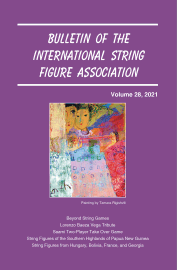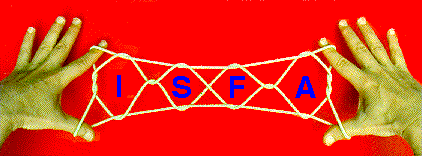Volume 28 (2021): 227 pages - Table des Matières
Edité par - Mark A. Sherman, Pasadena, California Rédacteurs Associés - Joseph D'Antoni, Queens, New York; Myriam Namolaru, Haifa, Israel; Belinda Holbrook, Davenport, Iowa; Stephan Claassen, Best, Netherlands. Comité de Rédaction - Hiroshi Noguchi, Tokyo, Japan; Philip Noble, Inverness, Ecosse Le Bulletin de l'Association Internationale du Jeu de Ficelle (BISFA) est une publication savante présentant des documents originaux qui fait progresser notre compréhension et renforce notre plaisir des jeux de ficelle. BISFA est publié annuellement, en septembre, par ISFA Press (Pasadena, Californie). BISFA remplace le Bulletin de l'Association des Jeux de Ficelle, (Toky Nippon Ayatori Kyokai), qui a été publiée en 19 volumes (1978-1993). Les traductions proposées ne comprennent pas les illustrations et photos du texte original. J'ai traduit ces textes pour vous donner un aperçu de la qualité et de la richesse de ces publications.

Research Reports
Beyond String Games by Philip D. Noble, Inverness, Scotland (pages 1-8) - In the past most string figure collectors doing field work have concentrated on recording the method of construction and final design, along with names, meanings, and chants. However, more recently, attention has been given to the context in which string figures are made. The finished string figure pattern is not viewed as something in itself but as part of a procedure for sharing community and fun. Most string figure play appears to be a corporate event even if the designs are being made by one person only. Others watch, advise, copy, and prepare their own versions. Those who seek to gain a deeper understanding of the significance of string figures are advised to be very aware of the whole string figure event from beginning to end.
Lorenzo Baeza Vega and his Contribution to Kaikai by Marcela Garrido Díaz, Santiago, Chile (pages 9-13) - For many years the location of Lorenzo Baeza Vega’s collection of Easter Island string figures, assembled in 1953-1955, has remained unknown. Its last known owner was Baeza’s widow, Adriana Martínez. In this article the author reveals that the collection has at last been located, and digitized to provide free access.
String Figures of the Southern Highlands of Papua New Guinea by Philip D. Noble, Inverness, Scotland (pages 14-32) - This paper presents fourteen string figures of the Wola from the southern highlands of Papua New Guinea. The figures were collected by Paul Sillitoe in the early 1970s. For three figures Sillitoe did record the construction method, presented here in a modified format. The other eleven are collected as mounted specimens along with a name and a description; for these figures possible construction methods are suggested.
A Saami two-player take over game, recorded by Yves Delaporte around 1970 by Stephan Claassen, Best, Netherlands (pages 33-54) - This paper presents an interpretation of the two-player take over game, in the English-speaking world often referred to as “Cat’s Cradle”. The game was recorded around 1970 by French ethnologist Yves Delaporte among the Saami of the Kautokeino area in the north of Norway. The presentation is accompanied by short comparative notes. The concept of Stages is introduced to describe the structure of the game. Three transitions between Stages have probably not been recorded in other parts of the world before.
Hungarian String Figures in Published Sources by Stephan Claassen, Best, Netherlands (pages 55-169) - This paper presents twelve string figures or series of figures, nine tricks, three knots used in folk medicine, one display of skill and one game for children; all are performed with a string loop or a length of string. They were found in publications in the Hungarian language that appeared in the period between 1904 and 2016. Two further examples of the two-player take over game are presented in appendices. The Hungarian string figure corpus clearly fits in the European tradition. Three string figures have probably not been described elsewhere; two of them are closely related to traditional weaving techniques. Some transitions in the two-player take over game were probably not seen before. Some Hungarian string tricks and knots are used in traditional folk medicine.
Some String Figures of the Moré (North-East Bolivia) as recorded by Emil Heinrich Snethlage in 1934 by Stephan Claassen, Best, Netherlands (pages 170-184) - In November 1934 German ethnologist Emil Heinrich Snethlage filmed the construction of three string figures among the Moré, living on the Bolivian border of Rio Guaporé. The figures are presented here, accompanied by comparative remarks and information on their context.
La Scie ("The Saw"), a 19th century string figure from France by Stephan Claassen, Best, Netherlands (pages 185-204) - Five independent French sources describe a 19th century two-player string figure called La Scie ("The Saw") or La Scie en Long ("The Pitsaw"). The figure also lends its name to the two-player take over game (called Cat's Cradle in the English-speaking world). The present paper presents the information found in the French sources, along with comparative notes and contextual information.
Letters to the Editor (pages 205-211)
"Threads", the Two-Player Take Over String Game from Georgia - Stephan Claassen. The author provides a transcription of a video made by artist Tamara Rigishvili of Tbilisi, Georgia, showing how "Cat's Cradle" (the two-player take over game) is played in her country. Attention is drawn to three less common transitions (Stage 6 to 4, Stage 5 to 4, and Stage 5 to 2).
Nomenclature - by Mark Sherman (pages 212-227)
Abbreviations and terms used throughout the Bulletin are summarized and illustrated. Step-by-step illustrations for making five string figures (Look!, Drum, Two Fawns, Face Mask, and Two Arrowheads) are provided as examples.
Ajouter un commentaire


